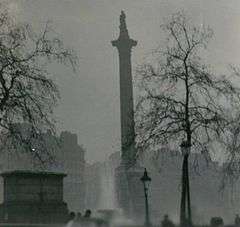Air pollution in the United Kingdom
Air pollution in the United Kingdom is monitored and regulated. Air quality targets for particulates, nitrogen dioxide and ozone,[1] set by the Department for Environment, Food and Rural Affairs (DEFRA), are mostly aimed at local government representatives responsible for the management of air quality in cities, where air quality management is the most urgent.
England Air management
If a local authority finds an area where the targets are not likely to be met, it must declare it an Air Quality Management Area (AQMA)[2] and produce a Local Air Quality Action Plan[3] to improve the air quality. DEFRA has published a list of local authorities with AQMAs.[4] The action plan may include measures for idle reduction of vehicle engines. An example is the Metropolitan Borough of Dudley.[5]
Published information
The UK has established an air quality network where levels of the key air pollutants[6] are published by monitoring centres.[7] Air quality in Oxford, Bath and London[8] is particularly poor. One controversial study[9] performed by the Calor Gas company and published in the Guardian newspaper compared walking in Oxford on an average day to smoking over sixty light cigarettes.
More precise comparisons can be collected from the UK Air Quality Archive[10] which allows the user to compare a cities management of pollutants against the national air quality objectives[11] set by DEFRA in 2000.
Localized peak values are often cited, but average values are also important to human health. The UK National Air Quality Information Archive offers almost real-time monitoring of "current maximum" air pollution measurements for many UK towns and cities.[12] This source offers a wide range of constantly updated data, including:
- Hourly Mean Ozone (µg/m³)
- Hourly Mean Nitrogen dioxide (µg/m³)
- Maximum 15-Minute Mean Sulphur dioxide (µg/m³)
- 8-Hour Mean Carbon monoxide (mg/m³)
- 24-Hour Mean PM10 (µg/m³ Grav Equiv)
DEFRA acknowledges that air pollution has a significant effect on health and has produced a simple banding index system[13] that is used to create a daily warning system that is issued by the BBC Weather Service to indicate air pollution levels.[14] DEFRA has published guidelines for people suffering from respiratory and heart diseases.[15]
Past problems
The Great Smog of 1952

Early in December 1952, a cold fog descended upon London. Because of the cold, Londoners began to burn more coal than usual. The resulting air pollution was trapped by the inversion layer formed by the dense mass of cold air. Concentrations of pollutants, coal smoke in particular, built up dramatically. The problem was made worse by use of low-quality, high-sulphur coal for home heating in London in order to permit export of higher-quality coal, because of the country's tenuous postwar economic situation. The "fog", or smog, was so thick that driving became difficult or impossible.[16] The extreme reduction in visibility was accompanied by an increase in criminal activity as well as transportation delays and a virtual shut down of the city. During the 4 day period of fog, at least 4,000 people died as a direct result of the weather.[17]
April 2014
More areas of England warned of 'very high' air pollutions in April 2014. High levels of pollution in London and other parts of the south east of England may at worst days cause sore eyes and sore throats and experts warned those with heart conditions and asthma to stay inside.[18][19]
April 2015
On 29 April 2015, the UK Supreme Court ruled that the government must take immediate action to cut air pollution,[20] following a case brought by environmental lawyers at ClientEarth.[21]
See also
- Clean Air Act 1956
- Environmental Protection UK
- Environmental history
- Environmental issue
- Pea soup fog
References
- ↑ http://uk-air.defra.gov.uk/assets/documents/National_air_quality_objectives.pdf
- ↑ http://uk-air.defra.gov.uk/aqma/
- ↑ http://laqm.defra.gov.uk/action-planning/aqap-supporting-guidance.html
- ↑ http://uk-air.defra.gov.uk/aqma/list
- ↑ http://www.dudley.gov.uk/business/environmental-health/pollution-control/air-quality/vehicle-air-pollution/
- ↑ The Department for Environment, Food & Rural Affairs (DEFRA): Air Pollution
- ↑ LAQM Air Quality Management Areas
- ↑ London
- ↑ Taking the Oxford air adds up to a 60-a-day habit (a newspaper article in The Guardian)
- ↑ UK Air Quality Archive
- ↑ UK National Air Quality Objectives
- ↑ Current Air Pollution Bulletin
- ↑ Air Pollution Bandings and Indexes
- ↑ BBC Weather Service
- ↑ Air Pollution - What it means for your health
- ↑ Nielsen, John (2002-12-12). "The Killer Fog of ’52: Thousands died as Poisonous Air Smothered London". National Public Radio.
- ↑ "On this Day: 1952 London Fog Clears After days of Chaos". BBC News. 2005-12-09.
- ↑ Smog alert: 'very high' air pollution levels spread across England
- ↑ text
- ↑ "Court orders UK to cut NO2 air pollution". BBC News (BBC). 29 April 2015. Retrieved 29 April 2015.
- ↑ "UK Supreme Court orders Government to take "immediate action" on air pollution". ClientEarth. 29 April 2015. Retrieved 29 April 2015.
Further reading
- Anderson, H. Ross. "Air pollution and mortality: A history." Atmospheric Environment (2009) 43#1 pp: 142-152.
- Brimblecombe, Peter. The Big Smoke: A History of Air Pollution in London Since Medieval Times (Methuen, 1987)
- Ciecieznski, N. J. "The Stench of Disease: Public Health and the Environment in Late-Medieval English towns and cities." Health, Culture and Society (2013) 4#1 pp: 91-104.
- Hanlon, W. Walker. "Pollution and Mortality in the 19th Century (UCLA and NBER, 2015) online
- Mosley, Stephen. "'A Network of Trust': Measuring and Monitoring Air Pollution in British Cities, 1912-1960." Environment and History (2009) 15#3 pp: 273-302.
- Thorsheim, Peter. Inventing Pollution: Coal, Smoke, and Culture in Britain since 1800 (2009)
- Williamson, Tom. An Environmental History of Wildlife in England 1650-1950 (A&C Black, 2013)
External links
| Wikimedia Commons has media related to Air pollution. |
| ||||||||||||||||||